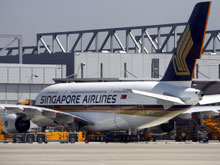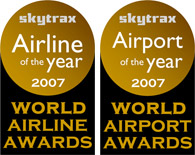Airbus’ A380 will embark for a series of demonstration tours starting on 30th August. Key airports in South-East-Asia and the U.S. will be visited.
The Asia-A380-tour will be conducted with flight-test-aircraft MSN 007, powered by four Rolls Royce Trend 900 engines. The world’s largest and most innovative passenger jet flying today is equipped with a full passenger cabin, which can comfortably carry 520 passengers in an extra quiet and relaxing three-class cabin-environment.
Airbus A380 World Tour Schedule
The International Airports to be visited are:
- Thailand, Bangkok / Chiang Mai — August 31 – September 2
- Vietnam, Hanoi — September 2-3
- China, Hongkong (Asian Aerospace) — September 3-5
- Korea, Seoul — September 5-7
The US-tour will take the A380 flight-test-aircraft MSN 009, powered by four Engine Alliance GP7200 engines, to the United States. The visits are part of the ongoing route proving process for this aircraft/engine-combination. The aircraft, which has no passenger-cabin, is on static display at the following airports:
- Connecticut, Bradley International Airport (BDL) — October 2-3
- Kentucky, Cincinnati/N. Kentucky Airport (CVG) — October 3-4
- California, San Francisco International Airport (SFO) — October 4-5
Updated destinations and dates at: Airbus A380 continues route proving tours
Both demonstration tours are part of the extensive campaign to prepare the A380 for a smooth entry into service. Operating under typical airline conditions, both aircraft will undergo airport compatibility checks, ground handling and maintenance procedures to confirm its readiness to enter service. The A380 has already visited more than 45 airports and by 2011, more than 70 airports will be ready for A380 operations.
Total orders and commitments for the A380 are 173 by 14 customers. The first customer A380 will be delivered to Singapore Airlines in October. Subsequent aircraft, for delivery to Singapore Airlines, Emirates Airlines and Qantas, are also well on track.
The A380 will provide more comfort in every class and more open space for relaxation than any other aircraft. Passengers will enjoy a new way of flying while benefiting from the quietest cabin in the sky. The aircrafts‘ efficiency and advanced technologies will result in outstanding economics and higher operational flexibility as seat-mile costs are 20 percent lower and range 15 percent greater compared to today’s existing large aircrafts.
Being cleaner, greener, quieter and smarter, the A380 is already setting new standards for transport and the environment. Per passenger, the A380 is as fuel efficient as a small economical family car. Requiring shorter runways for take off and landing, the A380 also provides vital extra passenger capacity without increasing the number of flights. So the aircraft is an ideal solution to today’s congested airports.

 In line with the announced plan of delivering the first A380 to Singapore Airlines in October 2007, Airbus today confirms that the formal hand-over will take place on Monday 15th of that month.
In line with the announced plan of delivering the first A380 to Singapore Airlines in October 2007, Airbus today confirms that the formal hand-over will take place on Monday 15th of that month. “Flightstory.net” is having a little break for the next 2 weeks!
“Flightstory.net” is having a little break for the next 2 weeks! International travellers have voted Hong Kong Best Airport in the World … the final results being the most closely contested in the history of the Skytrax global survey!
International travellers have voted Hong Kong Best Airport in the World … the final results being the most closely contested in the history of the Skytrax global survey!